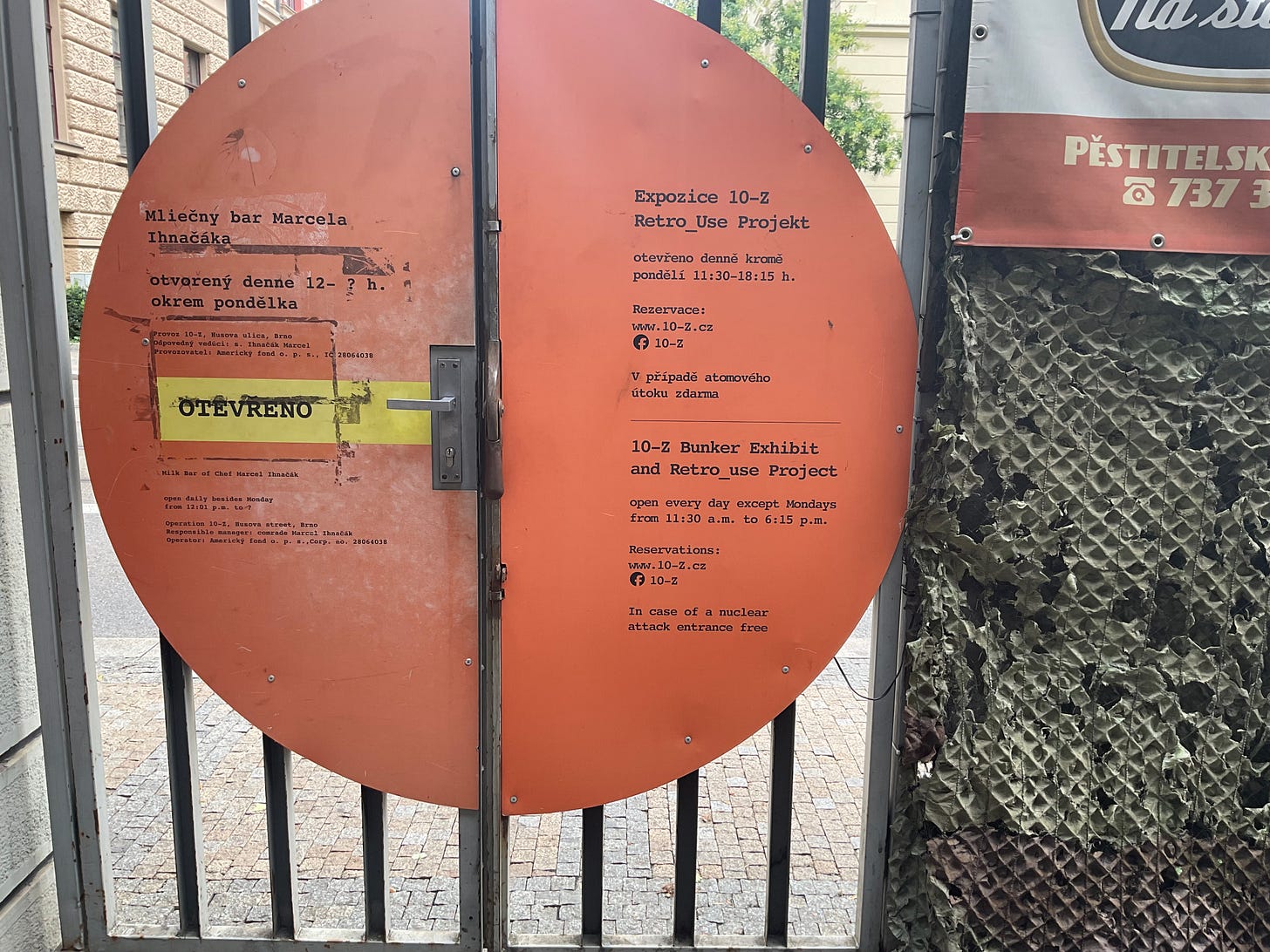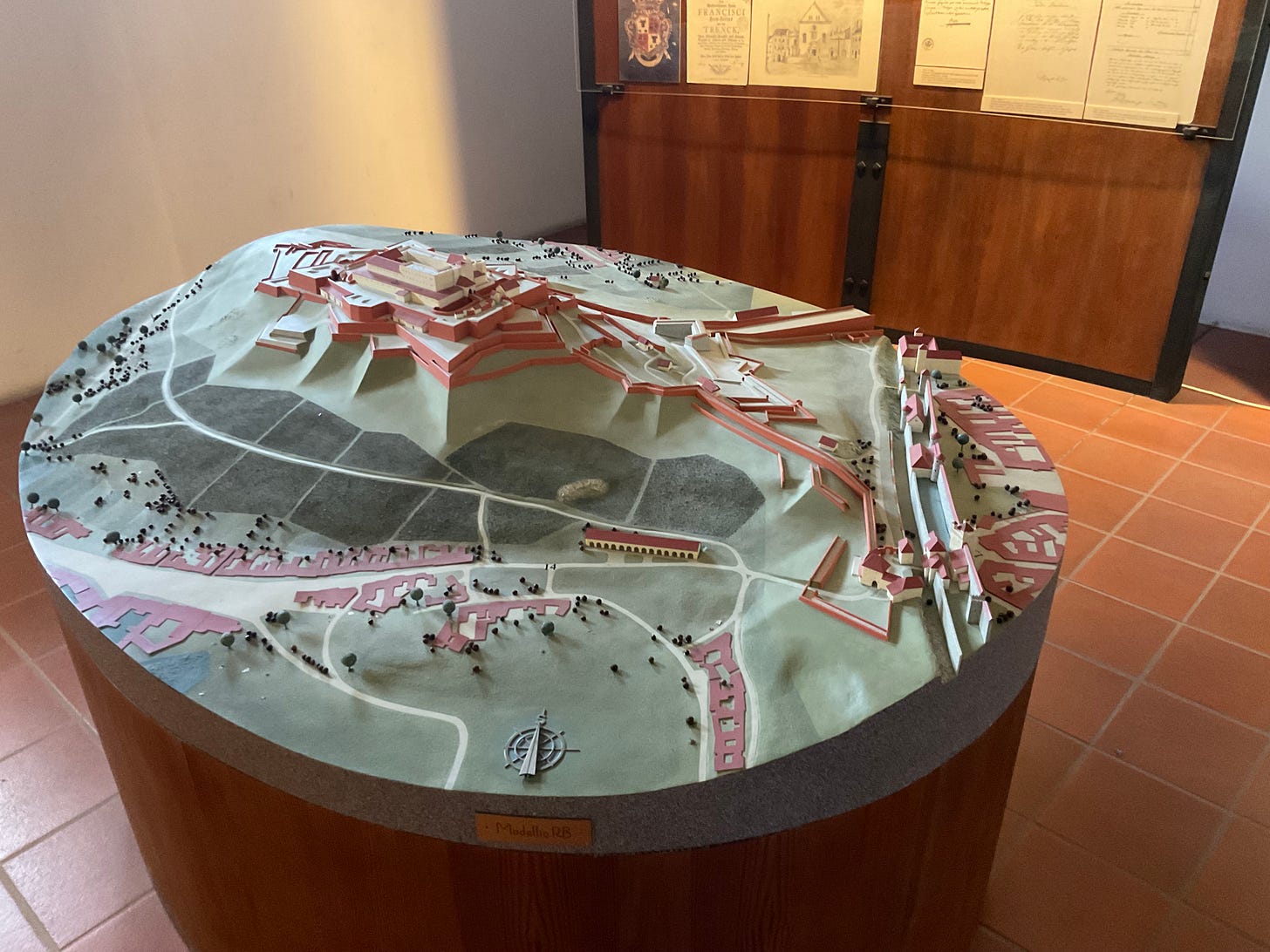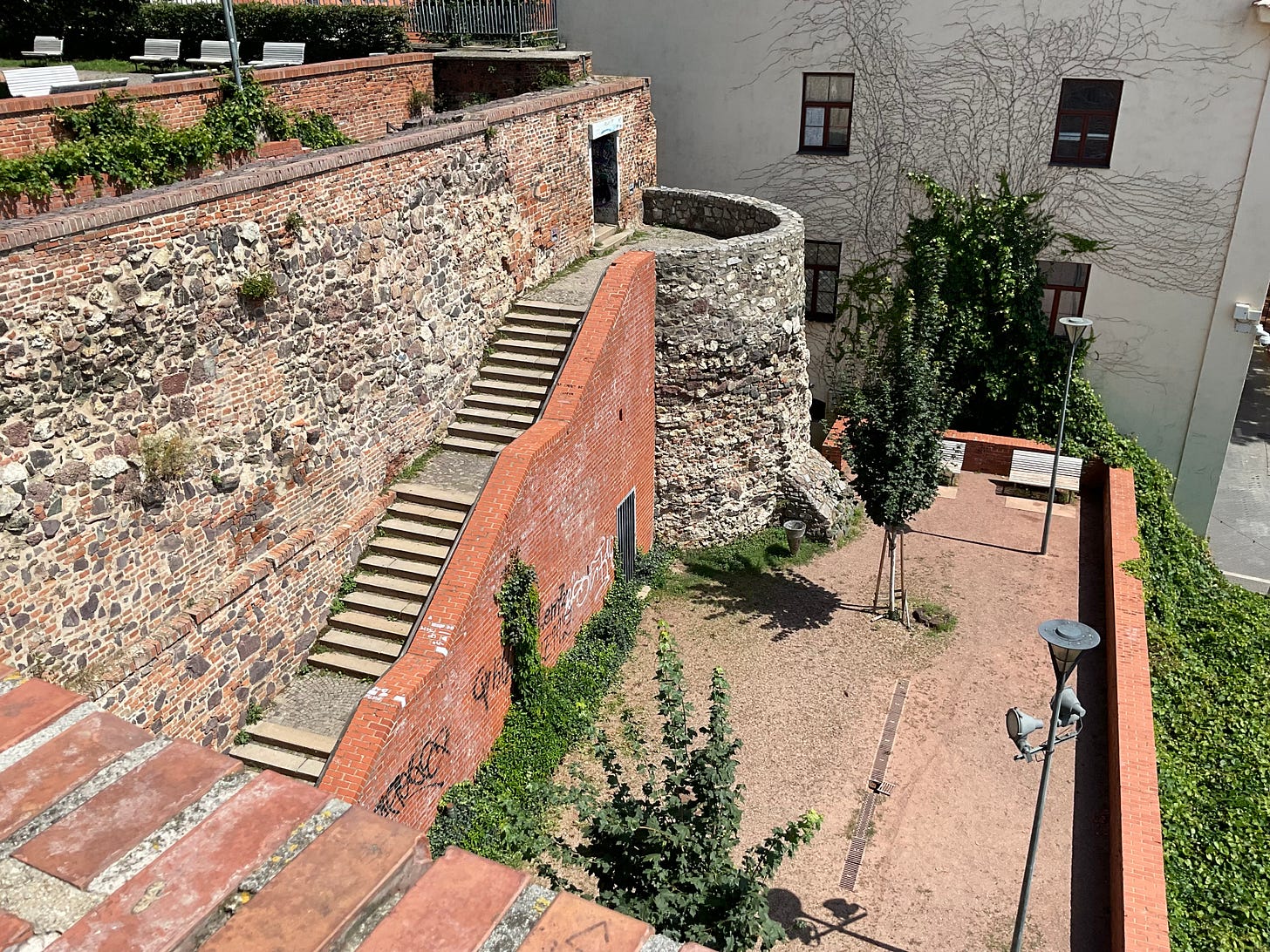Travel Diary 5: Bratislava, Brno, Sternberk, Prague
Globalisation and a sense of place.
Our last night in Bratislava, having had enough alcohol earlier after visting Hrad Devin, I explored some of the limonades one saw offered very widely in Central Europe. They included real fruit and were flavoursome without being particularly sweet.
Something the museum in Bratislava Castle made clear is that interwar Bratislava had embraced modernism in design and architecture. I am not a fan of modernism, but there were some impressive designs and one could see an attempt to forge a new post-Habsburg, post-Hungary identity.
At Hrad Devin, there were pictures of the triumphalist column Hungarians had erected on top of the castle in 1896 to celebrate 1000 years since the founding of Hungary. It was a fairly typical late C19th monstrosity. In 1921, members of the Slovak legion blew it up. Fair enough. A discreet statue of a Slovak peasant woman in the grounds of the castle may have been making its own statement about historical heritage and how to celebrate it.
With the very partial exception of Greater Moravia, historically, there was never a specfically Slovak state. But ethnicities are not built by politics, they are built by persistent patterns of connections built up over time.
Friday, we trained to Brno. A slightly chaotic exercise, as not everyone had allocated seats and there seemed to be more people than seats to start with.
The timetable was a matter of the time before which the train will not depart and allocating platform seemed to be something of an “as they go” exercise. It took quite some time before the departure board allocated a platform to the Brno-Prague train. It said platform 2, it actually departed from platform 4. Fortunately, that was just the other side of the same platform.
After arriving at Brno, we trammed to the Cold War bunker we were staying in. The bunker is in the hill that Spilberk Castle is on. As I panted with my backpack up the hill I asked “why are we going up the hill to get to the bunker?” That turned out to be a very good question. Trick with mapping apps: they go by GPS, so are capable of taking you to where the bunker is below you rather than where its entrance is.
The bunker was quite the experience. You even have to buzz yourself in about half way in the bunker. There are shared shower and toilet facilities. You pull the chain on the shower and you get about 5 minutes of water. Then you pull the chain again. It was quite cold in the bunker and towels didn’t really dry. Nigel ended up taking them into the public gardens surrounding the castle that the bunker was under to dry them.
Yet again, we discovered that Central Europeans generally cannot do coffee, other than as bitter caffeine. Yet, they can do chai — which was reliably flavoursome and not too sweet.
We walked down to the Old Town, which had a range of restaurants, though Italian seemed the dominant cuisine. The trams going along the tramlines in the middle of the main square clearly took the attitude that pedestrians had to keep out of the way. Safetyism is not a noted feature of Central Europe. One could observe several generations of trams as they rattled past.
We ended up having a lovely meal at Piazza restaurant, slightly interrupted by having to decamp inside when a sudden storm hit—rain and wind so strong it blew Nigel’s steak knife off the table made that seem an excellent idea. I had a very nicely cooked swordfish fillet and Nigel had what he assured me was an excellent steak. I had two glasses of a very fine Moravian pinot gris. We also ate there on the following two evenings, one of which included a pleasant Moravian malbec.
I found the very firm beds with sleeping bag in the bunker quite comfortable. Nigel didn’t. The breakfast was somewhat Spartan. Sufficiently so that, for the first time on the trip, Nigel decided to forego the free breakfast for the following two mornings.
Saturday, we walked up to Spilberk Castle, which we were literally under. On the weekends, the tours are only in Czech. Almost all the descriptions are in Czech. Still, Špilberk Castle is a fine example of a fortified position with multiple layers of construction. The exhibition includes a very good pictorial history of the castle.
The castle started as classic medieval “fortified high point in gap in mountains”. In the C16th, the castle was adapted for artillery. In the mid C18th, it was given the star-fortress treatment. The Habsburgs then decided it would be a good place for a prison. The lower prison was for ordinary criminals, the upper prison for prisoners of note. The successful resistance to the 1645 Swedish siege of the city was clearly a high point in the city’s history: partly as the aftermath established it as the main Moravian city, and the second city of the Kingdom of Bohemia—Emperor Ferdinand III was very grateful.
The French blew up many of the star-fortifications towards the end of the Wagram campaign. The Castle became just a prison. Franz Josef abolished the prison, and it became a military barracks and military prison. During the Second World War, bomb shelters were constructed in the basement of the castle. So, having slept in a Cold War nuclear bunker that morning, later the same day I was walking through a Second World War bomb-shelter and an C18th prison built on high medieval castle.
The prison exhibition included an effectively presented torture room. Common law replacing trial-by-ordeal with trial by a jury of one’s peers was definitely an improvement on using torture to produce the “queen of evidence” (confession).
While the region has a complicated interaction with the Habsburg legacy, they were clearly much better rulers for their subjects than their Ottoman and Romanov rivals.
The “From Renaissance to Modernism” exhibition on one floor of the Castle had no particularly remarkable piece of art, but precisely because they were simply period pieces, the shock of the Great War is all the more vivid. A coherent sense of legacy in architecture and aesthetics in art collapses. So much of what occurs in Europe from 1917 onwards makes sense in terms of a deeply traumatised civilisation.
Hence the art of trauma and an architecture of a stripped-of-heritage functionalism.
Sunday, we found a lovely breakfast place, walked the medieval walls (mostly where they had been) and went into St Martin’s Cathedral, whose inside was much more Baroque than the consistently Gothic outside led us to expect. Though there clearly had been some intent to make the Baroque fit in with the Gothic: apart from the dreadfully overdone pulpit. We also explored spritz’s that were not aperol in a cafe-restaurant in one of the parks.
Brno was where Gregor Mendel was a monk and conducted his famous experiments. Darwin had two out of the three mechanisms for his Theory of evolution. These being natural selection—Malthusian population pressure against resources—and sexual selection—the most startlingly original part of Darwin’s Theory. He did not have genetics, which Mendel’s experiments opened up. Hence what is sometimes referred to as the Darwin-Mendelian synthesis.
I have seen criticisms of Darwinian evolution on the grounds that random mutation will not produce the level of order we see in the biosphere within the observed time-frames. But the selection processes are not random: the search for strategies of survival and reproduction themselves have an ordering effect. Indeed, it fairly clearly creates selection for increased complexity. I have previously argued that sexual reproduction increases the selection “filters” so as to increase the chance of investing in viable complexity.
While walking (the route of) the medieval walls, we found a fabulous exhibition of Leonardo da Vinci’s machines based on wooden models of his designs, some of which one could actually be operated. The nice gentleman who sold the tickets turned out to be the guy who made the models.
Having observed various depictions, maps and models of medieval cities, it became clear that in river cities, you fortify away from the river bank, as otherwise the river port is a point of vulnerability and neither the warehouses nor any boats are worth the risks.
Sea cities, you do fortify the harbour as the warships, merchant vessels, and warehouses are worth defending, and such defense is part of what you are offering as a trading city.
Experiencing globalisation
Travelling around Central Europe and so four countries—Czechia, Austria, Hungary, Slovakia, back to Czechia—was an informative exercise in observing globalisation in operation.
An obvious point of globalisation was, for instance, buying a Schweppes bitter lemon in a local hole-in-the-wall shop: so common products. Another was common technology: such as paying by card and electronic funds transfer. A third was shared entertainment—notably films and songs. With Netflix and various apps—such as Viki and iQIYI—TV series also have become global. A fourth was the ubiquity of English. A fifth was mass transport, hence mass tourism.
The most in-your-face manifestation of globalisation was all the American food franchises—McDonald’s, Starbucks, Burger King, Subway, KFC, and so on. Though other franchises and chains were also in evidence, if not quite as flagrantly. The Argentinian El Gaucho restaurant we had a rather excellent meal in Bratislava was part of a chain.
Monday, after packing up and having another lovely breakfast, we were driven to Prague, stopping off at Sternberk Castle. The castle has been held by the same family since it was built in the 1240s. During the Communist period, the head of the family took a job at the castle, so was able to preserve much of the heritage. After the Velvet Revolution, the castle again became the family residence, though that clearly entailed some deal about public access.
It being Monday, there was no tour of the residence, which was therefore closed to the public. But Nigel and I enjoyed traipsing around the walls, walking up one of the towers, and the public area, which included a restaurant/cafe. Steps in a specific path down to the village at the base of the Castle suggested a functional, even relaxed, connection between castle and town that may help explain the Castle family’s staying power.
We were then driven on to Prague. During the drive we passed lots of cornfields, which explained why sweet corn had popped up in a lot of meals. Our driver, Yaroslav, provided some useful observations, though he became a little intimidated by how much historical knowledge Nigel and I already had. Nigel’s excellent memory and voluminous knowledge of military history certainly added to the trip. Yaroslav observed that the Czechs resisted German pressure better than many Western Slavs, due to the mountains and silver mines.
After three nights in a bunker, for our last night in Prague, we stayed in an Attic. Well, a room in the roof of the hotel. We wandered out and had some drinks and a fine carpaccio by the river at Bricks Terrace.
That evening, we walked to one of the older parts of Prague across the river from Prague Castle, to a silly “medieval” feast, which was quite well attended, despite being a Monday evening. The food was ample, though unremarkable. It included both potatoes and tomatoes, so was a complete authencity fail. That the entertainment included pirate duels just completed that. The belly dancing was arguably medieval, just not for Christian Europe.
Nigel had booked us in for the gluten-free table, due to my gluten intolerance. Unfortunately, we found out the next day that the food did not entirely agree with him, leaving him with a mildly unsettled stomach.
Tuesday morning, we walked to the square under Prague Castle and had a pleasant breakfast: in my case, an excellent omelette. Once again, I found just looking at architecture with a human sense of heritage restful.
Then we took a taxi to Prague airport—which we again found to be pleasantly efficient—and home, via another stopover in Dubai.
So, that was my trip to Central Europe, which I enjoyed immensely. This despite Nigel and I also being sick for the entire trip, due to a noxious cold we picked up on the way to Europe.
I do recommend a stopover night (and massage) if you are doing a long trip. I was also struck that Melbourne airport had the most mechanised ID check and entry processing. But Australia tends to lead in such mechanisation, especially as we have largely eschewed importing cheap (i.e. low-skill) migrants. Due to the points system, our migrants have a slightly higher average level education than the locally-born.
The Anglosphere—made up of three island countries, one island-continent and two continental countries that both border two oceans—is very much a creation of oceanic history. Travelling to inland, riverine countries, far from the coasts, with long and complicated histories, that took their history seriously—but in a generally matter-of-fact way—was informative.
One wonders if the matter-of-factedness was partly a reaction to Communist propagandised myth-making and partly a way to defuse their history. Either way, it was admirable.
Being among so much architecture that had a human sense of heritage—particularly given all the incorporated statues and faces—rather than a stark, inhuman functionalism was both inspiring and restful. It all left one with much to ponder on.














Ditto on RC's comment.
Nice how you manage to slip Darwin and evolution into so many essays. :-)
"I have seen criticisms of Darwinian evolution on the grounds that random mutation will not produce the level of order we see in the biosphere within the observed time-frames. But the selection processes are not random: the search for strategies of survival and reproduction themselves have an ordering effect. Indeed, it fairly clearly creates selection for increased complexity." Are you saying that complexity increases survivability? Perhaps, with increased phenotype complexity, there is more "sticking power" to not alter an enhancement back to the previous mean or baseline? [aka regression to the mean?] So more rapid selection towards improved survivability? Because there are more opportunities* for other genes to mutate, but those mutations don't impact that particular selection path? And conversely, a mutation in a complex form working against survivability will more rapidly cause that life line to die out? Thus leaving the more successful path to carry forward.
*But I thought I read somewhere that there is not a direct correlation between genetic complexity (# of genes/ chromosomes) and phenotype complexity?
Since you are in the Medieval history business, I hope you can take some of your travel and touring expenses as business expense deductions on your taxes ??? :-) Does Australian law follow elements of US law in that regard?
Wonderful observations and writing over the whole series.